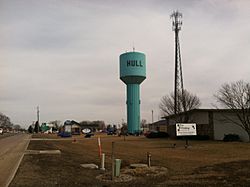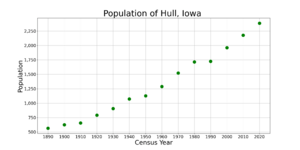Hull, Iowa facts for kids
Quick facts for kids
Hull, Iowa
|
|
|---|---|

Water tower located in the Hull (Iowa) Industrial Park just off US Highway 18.
|
|
| Motto(s):
Where Great Ideas Are Born
|
|

Location of Hull, Iowa
|
|
| Country | |
| State | |
| County | Sioux |
| Incorporated | May 15, 1886 |
| Government | |
| • Type | Mayor-council |
| Area | |
| • Total | 1.41 sq mi (3.64 km2) |
| • Land | 1.41 sq mi (3.64 km2) |
| • Water | 0.00 sq mi (0.00 km2) |
| Elevation | 1,440 ft (439 m) |
| Population
(2020)
|
|
| • Total | 2,384 |
| • Density | 1,695.59/sq mi (654.87/km2) |
| Time zone | UTC-6 (Central (CST)) |
| • Summer (DST) | UTC-5 (CDT) |
| ZIP code |
51239
|
| Area code(s) | 712 |
| FIPS code | 19-37515 |
| GNIS feature ID | 0457713 |
Hull is a city located in Sioux County, Iowa. It's a friendly place with a population of 2,384 people, according to the 2020 census.
Contents
History of Hull
The very first people to settle in the Hull area arrived in 1872. The city officially became a town on May 15, 1886. Hull was named after John A. T. Hull, who was a representative for Iowa in the United States House of Representatives.
Before it was called Hull, the town had a few other names. It was first known as Pattersonville, named after John G. Patterson. Later, it was called Winland before finally becoming Hull in the 1880s.
In 1993, a company from Hull called The Foreign Candy Company made history. They were the first American company to bring in the super sour Warheads candy!
A plan to build a park and cultural center, called Pattersonville Park, received a grant in 2004. Some of the money was returned in 2011 because the park wasn't built as planned.
Geography of Hull
Hull is located at 43°11′25″N 96°8′4″W / 43.19028°N 96.13444°W. This means it's in the northwestern part of Iowa.
The city covers a total area of about 1.20 square miles (3.11 square kilometers). All of this area is land, with no large bodies of water inside the city limits.
People of Hull: Demographics
The population of Hull has grown steadily over the years. In 1890, there were 566 people, and by 2020, the population had reached 2,384.
2020 Population Details
In 2020, there were 2,384 people living in Hull. There were 824 households, which are groups of people living together.
Most of the people in Hull are White (87.2%). Other groups include Black or African American (0.1%), Native American (0.5%), and Asian (0.8%). About 13.1% of the population identified as Hispanic or Latino.
The average age in Hull was 33.9 years. About 33.8% of the residents were under 20 years old, showing a good number of young people and families.
Education in Hull
Hull is part of the Boyden–Hull Community School District. This district has an elementary school in Boyden and a junior/high school in Hull. The district's main office is also located at the junior/high school in Hull.
There are also several private schools in the area:
- Hull Christian School
- Hull Protestant Reformed Christian School
- Trinity Christian High School
- Western Christian High School
Economy and Businesses in Hull
Hull is in Northwest Iowa, so its economy is closely linked to farming. Many businesses in Hull support the agricultural industry.
Local Businesses
Agropur Cooperative is a large company in Hull and is the biggest employer in the city. The Foreign Candy Company, which brings in Warheads and other candies, started in Hull in 1978.
The popular Pizza Ranch restaurant chain also began in Hull in 1981. A Subway sandwich shop opened in Hull in 2013.
The Hull Co-op Society helps local farmers with services like grain storage and feed. Other businesses include Hull Feed and Produce and Hull Veterinary Clinic.
A grocery store called Tom's Foodland, which later became Hull Food Center, was a long-time business. It closed in 2021 due to the pandemic. However, a new Fareway grocery store opened in Hull in July 2024.
Banking and Finance
Hull has two banks: Iowa State Bank and American State Bank. Iowa State Bank has been around for a long time, starting in 1879. It briefly closed during the Great Depression but reopened in 1934.
American State Bank moved to Hull in 2004 and built a new building in 2007. It also has branches in other nearby towns and is the largest bank in Sioux County.
Notable People from Hull
Many interesting people have connections to Hull, Iowa. Here are a few:
- Dwayne Alons – A member of the Iowa State House of Representatives.
- Randy Feenstra – Served in the Iowa Senate and the United States House of Representatives.
- Nancy Metcalf – An American indoor volleyball player.
- Wilmon Newell – A scientist who studied insects (an entomologist).
- William Earl Rowe – The 20th lieutenant governor of Ontario, Canada.
- Alexander Grant Ruthven – Was the president of the University of Michigan for many years (1929–1951).
See also
 In Spanish: Hull (Iowa) para niños
In Spanish: Hull (Iowa) para niños


